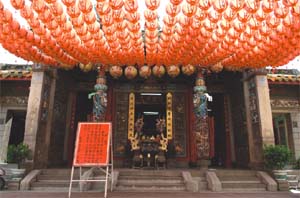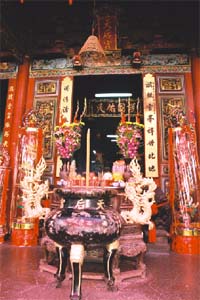Cihou Tianhou Temple / 旗後天后宮
◎Written by Yu-Fong Wang
◎Photograph by Jung-Hui Pao
 Life in Kaohsiung has always been closely affiliated with the ocean, even in relation to religion. The traditional Sea Goddess, Matsu, can be worshipped in the oldest temple in Kaohsiung, the Tianhou Temple which was built in 1673. During the celebration of the 333rd anniversary of the temple, the Kaohsiung City Government is hosting a "Matsu Cultural Festival" at Cijin Tianhou Temple for citizens to learn about this historical area.
Life in Kaohsiung has always been closely affiliated with the ocean, even in relation to religion. The traditional Sea Goddess, Matsu, can be worshipped in the oldest temple in Kaohsiung, the Tianhou Temple which was built in 1673. During the celebration of the 333rd anniversary of the temple, the Kaohsiung City Government is hosting a "Matsu Cultural Festival" at Cijin Tianhou Temple for citizens to learn about this historical area.
There's a close relationship between the establishment of Cijin Tianhou Temple and the development of Kaohsiung. Due to the high number of mullets in the oceans surrounding southern Taiwan, fishermen from Mainland China have always been attracted to Kaohsiung. In 1673, a fisherman named Ah-Hua Hsu was fishing off the coast of Kaohsiung when a typhoon struck, and so he sought refuge at Cijin. He found Cijin to be beautiful and ideally located in terms of fishing; therefore, he set up a life at Cijin.
Soon after, Ah-Hua Hsu went back home and told his friends. Then six of them moved to Cihou, Cijin, and became the earliest residents of Cihou. According to tradition, fishermen will build a simple Matsu Temple in order to pray for safety when fishing. This was how the Cihou Tianhou Temple was founded.
By the year 1691, the population of Cihou had increased so much that the original residents feared that the Matsu Temple was going to be illegally occupied. Therefore, a meeting was held whereby an agreement was written down stating the area of the Matsu Temple. The agreement also covered the development of Cijin and the process of establishing the Matsu Temple, which showed the importance of the Matsu Temple in the history of the development of Kaohsiung.
With the population increase at Cijin, the Matsu Temple became increasingly important. There were once many rocks in Kaohsiung Port that caused accidents for many small boats traveling between Cijin and Kaohsiung. Therefore, not only do the deep-sea fishermen pray to Matsu, but also the residents of Cijin who regularly use the harbor. Since then, the Matsu Temple has always been full of people burning incense, making it one of the most important Temples in Kaohsiung.
Cijin Tianhou Temple has been renovated numerous times over its history. During the early 18th century, there was an increase in residents at Cijin, and these residents collected money and used it to rebuild the walls out of stone. In 1887, with the development of the port, many businessmen from overseas also donated money to renovate Tianhou Temple. In 1927, Ji-liu Tsai bought brick, stones and wood from Mainland China to rebuild Tianhou Temple. However, today's Tianhou Temple is the work of Wen-bin Tsai in 1948.
Despite the numerous renovations, Tianhou Temple has kept its traditional Taiwanese elements; many of these elements dating back to the Ching Dynasty. It is now regarded as a "third grade national historical building", but, in the minds of the residents of Cijin, the most precious thing about it is its relationship with the people, which has survived for over three hundred years.
◎文/王御風
◎攝影/鮑忠暉
 高雄市依海為生,在生活、信仰上,也與海洋脫離不了關係,傳統華人地區的海洋守護神是媽祖,在高雄市所能找到的最早廟宇中,媽祖廟自然也在其中。建於1673年(清康熙12年、明永曆27年)的旗津天后宮是高雄地區最早建立的媽祖廟,今年(2006年)剛好是建廟滿333週年,市府特地在今年的媽祖誕辰於旗津天后宮舉行「媽祖文化節」,讓市民對這個高市最早的開發地有更深入的瞭解。
高雄市依海為生,在生活、信仰上,也與海洋脫離不了關係,傳統華人地區的海洋守護神是媽祖,在高雄市所能找到的最早廟宇中,媽祖廟自然也在其中。建於1673年(清康熙12年、明永曆27年)的旗津天后宮是高雄地區最早建立的媽祖廟,今年(2006年)剛好是建廟滿333週年,市府特地在今年的媽祖誕辰於旗津天后宮舉行「媽祖文化節」,讓市民對這個高市最早的開發地有更深入的瞭解。
旗津天后宮的建立,與高市最早的開發密不可分。台灣南部自古盛產烏魚,每逢烏魚季節,就會吸引許多大陸漁民來此捕魚,1673年,有位漁民徐阿華,駕駛自己的漁船來到高雄附近,不料碰到颱風侵襲,於是躲到旗後,暫避風雨,才赫然發現這裡山光水色、風景秀麗,又鄰近漁場,決意搬來此定居。
徐阿華返鄉後,告知其同鄉漁民,共有蔡月等六人與其前來定居開墾,成為旗後最早的住民。來到此地,漁民也承襲傳統,在附近搭建一間簡陋的媽祖廟,祈求讓其出海捕魚平安,這也就是旗後天后宮的由來。
到了1691年(康熙30年),旗後居民越來越多,居民們擔心媽祖廟被人侵佔,於是會同各姓大老,共立契約,明確標示媽祖廟的範圍。這份地契,透露出旗津開發與媽祖廟的建立過程,也說明媽祖廟在高雄市開發史上的地位。
隨著旗津人口的增加,媽祖廟的重要性越來越高,不僅漁民出海捕魚要祈求媽祖保佑,因當時高雄港內有許多巨石,來往旗津與高雄間的小船常出事,於是航行於港內的船隻及乘船民眾,也紛紛尋求媽祖的庇護,使得媽祖廟香火更鼎盛,成為高雄附近最重要的廟宇之一。
在歲月的流逝下,旗津天后宮也經歷多次的整修。乾隆年間(18世紀),旗津居民越來越多,原本簡陋的天后宮,在民眾籌資下,改為石壁小廟。1887年(清光緒13年)隨著打狗開港,許多洋商到旗津做生意,也捐錢重新翻修,讓天后宮煥然一新。1927年(日昭和2年),信徒蔡吉六從大陸購買大批紅磚、石材、木料改建,天后宮逐漸有今日的雛形。今天的天后宮則是於1948年(民國37年)由地方名士蔡文賓等整修完成。
在多次修整下,天后宮不但保有傳統台灣民間建築的精華,還有許多從清代留下來的匾額,因此被列為國家三級古蹟,但在旗津民眾心中,其最珍貴處,應該是它見證著旗津三百多年來的成長,那份與旗津共同的情感。